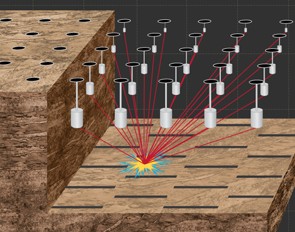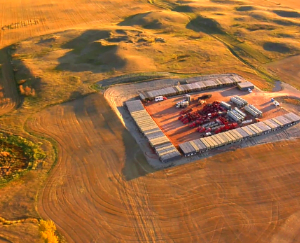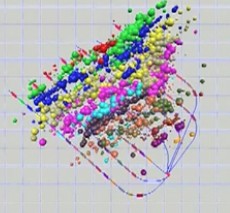
While horizontal drilling and multi-stage fracking are driving the shale oil and gas revolution across North America, drillers have found that what works in one field doesn't always travel well to the next. The geology of each new site must be sussed-out and solved, and that requires constant innovation. Just seven years ago, few thought that laying out hundreds or even thousands of passive seismic receivers over one hundred square miles to set up what is, in effect, a giant microphone thousands of feet above a shale oil or gas reservoir, would allow geologists to record and map the exact location of the cracks created by hydraulic fracking.
MicroSeismic's acceptance grew slowly
This tool evolved from technology used to monitor earthquakes and geothermal activity. Houston-based MicroSeismic extended the capability to monitor gas shale fracking from the surface, so operators can interpret in real time the vibrations triggered when tons of fracking fluids and proppants are pumped at high pressure into reservoirs deep underground. Watch a company CGI demo above: Like most technological innovations, MicroSeismic's acceptance and adoption started slowly. When founder Dr. Peter Duncan first pitched his idea to investors, he received a collective shrug. At the time, most companies relied on an expensive parallel downhole monitor wells into which seismic imaging equipment was installed. So, in 2005, the company barely managed to raise the $7 million in start-up money that Duncan thought he needed to bring the concept to market. (Duncan explains startup.) "When we came into the market, the established service providers using the legacy earthquake detection technique pushed back pretty hard," Duncan recalled to New Technology Magazine. "They said that these surface arrays can't work, and it was really just a matter that they didn't understand multi-channel seismic processing.
Field data is relayed to a central facility in Denver
Three years later, Denver-based Whiting Petroleum became one of MicroSeismic's early adopters. Among Whiting's largest projects were its North Dakota operations in the

Bakken and Three Forks shale plays, making it the second largest oil producer in the state (watch video backgrounder). After using MicroSeismic's technology, Whiting stopped drilling traditional parallel monitor wells on its vast acreage, which created immediate production savings. Now the company relies exclusively on seismic geophones buried in boreholes 3,000-4,000 feet apart across the entire 152 sqm reservoir, with each recording station connected by a custom wireless network to the field station. The fresh field data is relayed continuously to a central facility in Denver, Colorado, where MicroSeismic's patented Passive Seismic Emission Tomography (PSET) software evaluates and models the formation and the fracture. "The variability of the shales from well to well is driving more and more operators to monitor 30 to 40 per cent of their wells, and in some plays 100 per cent," Duncan told New Technology Magazine. "As the unit price comes down, operators are able to employ the monitoring on more and more wells. At some price point it will make sense to do it on every well."

A Whiting report noted that the MicroSeismic array had allowed the company to gather data on every fracture; the information was "useful in determining the direction and effectiveness, along with assisting in the cost-effective spacing of field wellbores." The technology has also been adopted by some of the largest exploration companies in the US, Duncan said, in tight gas plays from the Marcellus and Haynesville along with the Bakken tight oil play in Saskatchewan. "It has become a tool for putting arrays over entire oilfields, turning them on and listening to all the production activity in the oilfield," Duncan stressed to New Technology Magazine, "in order to hear those sensitive sounds, pinpoint their location, and really allow the engineer to know the dynamics in his oilfield." Finally, MicroSeismic's future will help to reveal the hidden world of fracking at a critical juncture in terms of public scrutiny, Microseismic's technology can provide answers to all sides of the "fracking" debate - operators, communities, landowners and government regulators.


